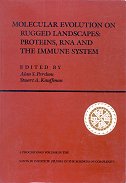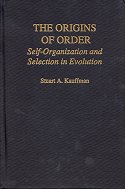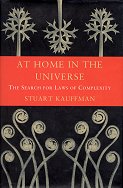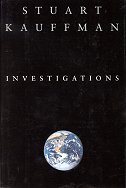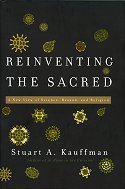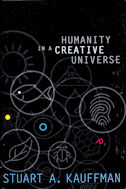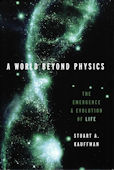I have been reading this book slowly over the past few weeks.
Slowly, because it is so densely full of new and wonderful insights
that I needed time to absorb them, and slowly, because I simply didn't
want it to finish. And now I have finished it, I have to review it.
But how to review a book like this? It is so marvelously original and
stunningly imaginative, and so full of profound ideas, that a short
review cannot possibly hope to do it justice. Go and read it yourself.
In his previous book, At Home in the Universe,
Kaufmann discusses spontaneous emergent self-organisation. Here he
takes his ideas, I was going to say a step, but actually it is a giant
leap, further forward, covering life, evolution, and the universe
itself. And fortunately his prose style, although still slightly
over-poetic in places for my personal taste, is a lot less purple than
before.
He starts small, with a definition of life suitably broad enough for
a general biology (that is, one not constrained merely to the
contingent developments of life on earth).
An autonomous
agent is a self-reproducing system able to perform at least one
thermodynamic work cycle. ... An autonomous agent is a physical system
... that can act on its own behalf in an environment. ... I suspect
that the concept of an autonomous agent ... defines life.
The quoted definition may look rather bald, but he discusses each of
the aspects -- self reproducing autocatalytic systems, work, and work
cycles, in fascinating detail. [But I do wonder if self-reproduction
is a necessary condition for life -- maybe it is simply one possible
mechanism?]
... work is the
constrained release of energy. ... it typically takes work itself to
construct the constraints on the release of energy that then
constitutes work.
Chapter 2 comes as a bit of a shock after the readily readable
chapter 1 -- it assumes rather more detailed biochemistry than I have
-- but keep courage and keep reading -- there's lots of explanation,
with lots of different examples.
There is a lot of discussion on how life is necessarily a
non-equilibrium system, and how non-equilibrium systems can
(self-)organise to do the work required for life.
In a
nonequilibrium setting, measurements can be ... used to extract work
from the measured system. ... only some features of a nonequilibrium
system, if measured, reveal displacements from equilibrium from which
work can, in principle, be extracted. ... there remains the issue of
how the [agent] knows to measure those features rather than other
useless features
We get discussions of systems building themselves recursively. To
survive, systems like cells need to be close to, but on the stable
side of, the edge of chaos, lest they lose their identity under the
onslaught of novelty. They operate recursively, reaching some kind of
'fixed point', or attractor. Kauffman wonders if Category Theory, with
the elements recursively constructing themselves, might be a suitable
mathematical basis for these systems. On the other hand, evolving
things like ecosystems are 'supercritical', constantly generating new
kinds of members, with a generative, non-convergent, open-ended,
forever growing recursion. Current computer models seem to be able to
generate at most a few levels of novelty, and have not yet
demonstrated ever increasing novelty.
But simply getting a good definition of life isn't enough for
Kauffman. He goes on to describe how life evolves and coevolves, how
complexity necessarily flows into the "adjacent possible"
(the states a single step away from the system's current state), and
why the science of this kind of evolution is qualitatively different
from "classical" science: because it is impossible even in
principle [I am not sure I agree with that "in principle",
but I do with the sufficient "in practice"] to finitely
prespecify the state space [Cohen
and Stewart also make this
point -- their favourite examples are oxygen and grass], and because
the evolution of the universe is so vastly non-ergodic, so vastly
contingent. He discusses that the contingent evolution of the world is
confined not just to the species level,
but is present in the molecules that go to make up life on earth, and
maybe even the fundamental laws of nature themselves.
... autonomous
agents forever push their way into novelty---molecular, morphological,
behavioural, organizational. I will formalize this push into novelty
as the mathematical concept of an "adjacent possible",
persistently explored ... Biospheres, on average, may enter their
adjacent possible as rapidly as they can sustain; so too may
econospheres. Then the hoped-for fourth law of thermodynamics for such
self-constructing systems will be that they tend to maximize their
dimensionality, the number of types of events that can happen next.
... this
nonequilibrium flow into a persistent adjacent possible may be the
proper arrow of time, rather than the more familiar appeal to the
second law of thermodynamics in closed thermodynamical systems.
Having covered life, and how it evolves, he next goes on to asking
why evolution works. Macready and Wolpert's "no-free-lunch"
theorem tells us that there is no one search algorithm better than any
other when its performance is averaged over all search
landscapes. Random search is as good as any other on average. So how
come the search algorithms evolution uses just happen to be ones that
work well on the evolutionary fitness landscape? Coincidence? No. The
creatures and the fitness landscapes co-construct each other:
If organisms
are sexual because recombination is a good search strategy, but
recombination is only useful as a search strategy on certain classes
of fitness landscapes, where did those fitness landscapes come from?
... The ways of making a living presenting fitness landscapes that can
be well searched by the procedures that organisms have in hand
[mutation, recombination, selection] will be the very ways of making a
living that readily come into existence.
Kauffman doesn't like anything to be coincidence. In his
final chapters he leaves biology, and ventures into economics and
fundamental physics.
In an evolving economic world, where new goods and services are
forever coming into being, where the future goods available cannot be
prespecified, the old ideas of equilibrium economics and clearing
markets cannot hold. He shows that economic agents on coevolving
fitness landscapes must necessarily have bounded rationality -- they
can use only recent data in building predictive models of other
agents, data from when the landscapes were roughly as they are now,
and they can devise only simple theories, to avoid overfitting the
sparse data. Ironically, in periods of relative stability, the
available data increase and the theories can get more sophisticated,
but hence more fragile, until a small change in reality can cause
catastrophic failure of the now fragile models, and result in an
avalanche of new behaviours and consequently requirements for new
models: hence cycles of stability and rapid change. [Here, for
Kauffman's argument to work, the economic fitness landscape must be of
a sort readily searchable by the search procedures the economic agents
have to hand -- but he doesn't say what these procedures are --
mutation and selection, clearly -- but what is the economic analogue
to biology's sexual recombination?]
Finally, Kauffman considers the universe itself, and has a dislike
for even the weak anthropic principle -- he wants to explain
why the universe has to be the way it is, or at least, close
to the way it is. He uses quantum decoherence (covered in some detail
in The Quark and the Jaguar)
to explain why the universe is getting more complex. Bigger systems,
more complex systems, decohere more rapidly, and hence preferentially
come into classical existence. He then applies Feynman's idea of sums
over histories and constructive quantum interference to explain why
the universe has the laws and geometry it does. Nearby histories
constructively interfere when they are similar -- when small changes
to whatever is being measured lead to small changes in the outcomes --
which might help explain our smooth and flat space-time: the irregular
ones have destructively interfered themselves out of existence. [I
admit to having missed the point here -- Kauffman seems to be saying
that the universe gets ever more complex because the complex
co-observing systems decohere -- become classical -- fastest, whilst
we get flat space-time because that is the geometry that decoheres
slowest. But maybe I can be excused this lapse in
understanding: the writing is at its densest here, with whole new
cosmologies packed into a few spare paragraphs. I would love to see
this chapter expanded into a whole book of its own. Some of it can be
found in The Life of the
Cosmos, but most goes beyond that.]
In all, this is a glorious, mind-expanding book. My attempts at
summarising Kauffman's many rich, diverse arguments cannot possibly do
them justice. I have just skimmed the surface of his thesis here.
There are many more fascinating details and arguments in the book.
Read it. And if its ideas are not yet in your own adjacent possible,
go and do some background reading (not helped by the rather sparse
bibliography herein), then read it.
